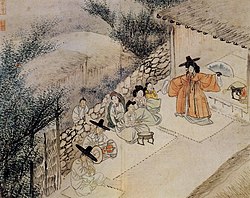| Korean mythology | |
 Early 19th-century painting depicting thirty-two shamanic deities. The three young gods in white wearing conical caps (bottom center) are the Jeseok triplets, gods of fertility that appear in the Jeseok bon-puri, the most widespread Korean myth. | |
| Korean name | |
|---|---|
| Hangul | 한국 신화 |
| Hanja | 韓國神話 |
| Revised Romanization | Hanguk sinhwa |
| McCune–Reischauer | Han'guk sinhwa |
| Part of a series on |
| Korean shamanism |
|---|
 |
Korean mythology (Korean: 한국 신화; Hanja: 韓國神話; MR: Han'guk sinhwa) is the group of myths[a] told by historical and modern Koreans. There are two types: the written, literary mythology in traditional histories, mostly about the founding monarchs of various historical kingdoms, and the much larger and more diverse oral mythology, mostly narratives sung by shamans or priestesses (mansin) in rituals invoking the gods and which are still considered sacred today.
The historicized state-foundation myths representing the bulk of the literary mythology are preserved in Classical Chinese-language works such as Samguk sagi and Samguk yusa. One state's foundation myth, that of Dangun, has become the founding myth of the whole Korean nation. State-foundation myths are further divided into northern, such as that of the kingdom of Goguryeo and its founder Jumong, where the founder is the son of a celestial male figure and an earthly female figure, and southern, such as that of the kingdom of Silla and its founder Hyeokgeose, where the founder begins as an object descended from the heavens, and himself marries an earthly woman. Other literary myths include the origin myths of family lineages recorded in genealogies.
The narratives of Korean shamanism, the country's indigenous religion, feature a diverse array of both gods and humans. They are recited in ritual contexts both to please the gods and to entertain the human worshippers. As oral literature, the shamanic narrative is regularly revised with each performance, although a certain degree of consistency is required; new narratives have appeared since the 1960s. It has frequently been at odds with the official ideologies of Korean society, and its mythology is often characterized as subversive of traditional norms such as patriarchy.
The shamanic mythology is divided into five regional traditions, with each region having original narratives, as well as distinctive versions of pan-Korean narratives. The mythological tradition of southern Jeju Island is especially divergent. The two narratives found in all but one region respectively are the Jeseok bon-puri, featuring a girl who in most versions is impregnated by a supernaturally potent Buddhist priest—who was probably originally a sky god—and gives birth to triplets who themselves become gods; and the Princess Bari, about a princess who is abandoned by her father for being a girl and who later resurrects her dead parents with the flower of life.
Cite error: There are <ref group=lower-alpha> tags or {{efn}} templates on this page, but the references will not show without a {{reflist|group=lower-alpha}} template or {{notelist}} template (see the help page).